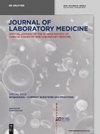Non-invasive prenatal paternity testing using mini-STR-based next-generation sequencing: a pilot study
IF 1.1
4区 医学
Q4 MEDICAL LABORATORY TECHNOLOGY
引用次数: 0
Abstract
Abstract Objectives To assess the efficacy of a mini-STR-based next-generation sequencing (NGS) method for non-invasive prenatal paternity testing (NIPPT). Methods Plasma DNA from 28 pregnant women was extracted and cell-free foetal DNA (cffDNA) genotyping was performed at 23 mini-STR loci using the Illumina NextSeq 500 system. For each mini-STR locus, the cffDNA genotype was validated by determining infant DNA genotype. The mini-STR loci with high concordance rates were selected for the comparison of STR genotyping results between cffDNA and biological father DNA or random male DNA for each family. Results The biological relationship was identified between alleged fathers and infants in all 28 families using the capillary electrophoresis (CE) method. Moreover, the concordance rates of STR genotypes D5S818, D19S253, and D21S1270 were less than 50% in 23 autosomal STR loci. The STR genotype matching probability was calculated using 20 STR loci with more than 60% concordance rate. There was a significant difference in the STR genotype matching probability between cffDNA and the DNA from the biological father (75–100%) or from random males (25–70%) (p<0.0001). Conclusions Our study demonstrated that mini-STR can be used for NGS-based NIPPT. Furthermore, this method can be used for crime control purposes using the STR data available from the national forensic DNA databases.使用基于迷你STR的下一代测序的无创产前亲子鉴定:一项试点研究
目的评价基于mini- str的下一代测序(NGS)方法在无创产前亲子鉴定(NIPPT)中的应用效果。方法提取28例孕妇的血浆DNA,采用Illumina NextSeq 500系统对23个mini-STR位点进行无细胞胎儿DNA (cffDNA)基因分型。对于每个mini-STR位点,通过测定婴儿DNA基因型来验证cffDNA基因型。选择一致性较高的mini-STR基因座与各家族的亲生父亲DNA或随机男性DNA进行STR基因分型比较。结果用毛细管电泳(CE)方法鉴定了28个家庭中疑似父亲与婴儿的生物学关系。在23个常染色体STR基因座中,D5S818、D19S253和D21S1270基因型的符合率均小于50%。选取20个STR基因型匹配率大于60%的位点计算STR基因型匹配概率。cffDNA与亲生父亲DNA的STR基因型匹配概率(75-100%)和随机男性DNA的STR基因型匹配概率(25-70%)差异有统计学意义(p<0.0001)。结论本研究表明mini-STR可用于ngs型NIPPT。此外,这种方法可用于犯罪控制目的,利用国家法医DNA数据库提供的STR数据。
本文章由计算机程序翻译,如有差异,请以英文原文为准。
求助全文
约1分钟内获得全文
求助全文
来源期刊

Journal of Laboratory Medicine
Mathematics-Discrete Mathematics and Combinatorics
CiteScore
2.50
自引率
0.00%
发文量
39
审稿时长
10 weeks
期刊介绍:
The Journal of Laboratory Medicine (JLM) is a bi-monthly published journal that reports on the latest developments in laboratory medicine. Particular focus is placed on the diagnostic aspects of the clinical laboratory, although technical, regulatory, and educational topics are equally covered. The Journal specializes in the publication of high-standard, competent and timely review articles on clinical, methodological and pathogenic aspects of modern laboratory diagnostics. These reviews are critically reviewed by expert reviewers and JLM’s Associate Editors who are specialists in the various subdisciplines of laboratory medicine. In addition, JLM publishes original research articles, case reports, point/counterpoint articles and letters to the editor, all of which are peer reviewed by at least two experts in the field.
 求助内容:
求助内容: 应助结果提醒方式:
应助结果提醒方式:


